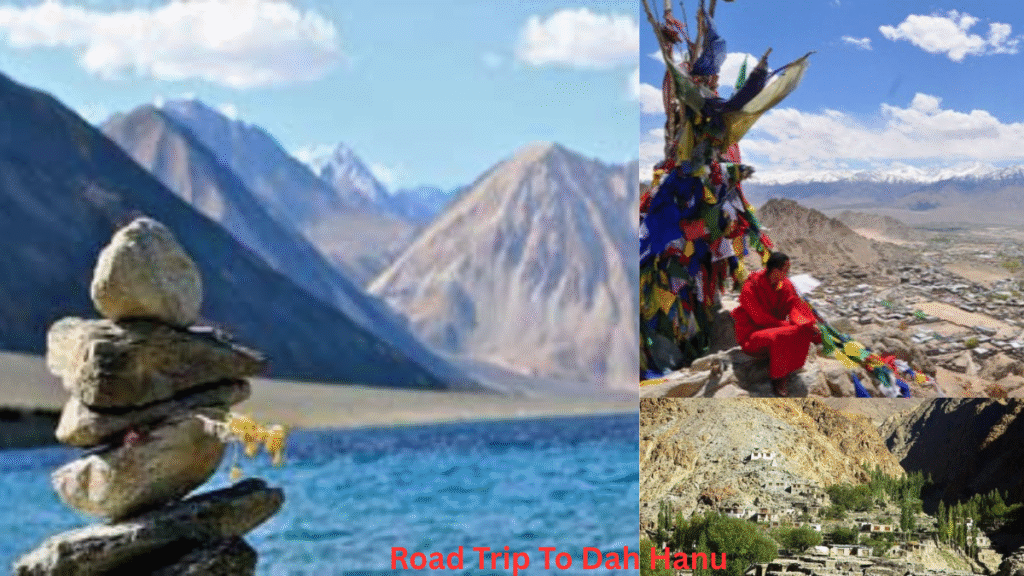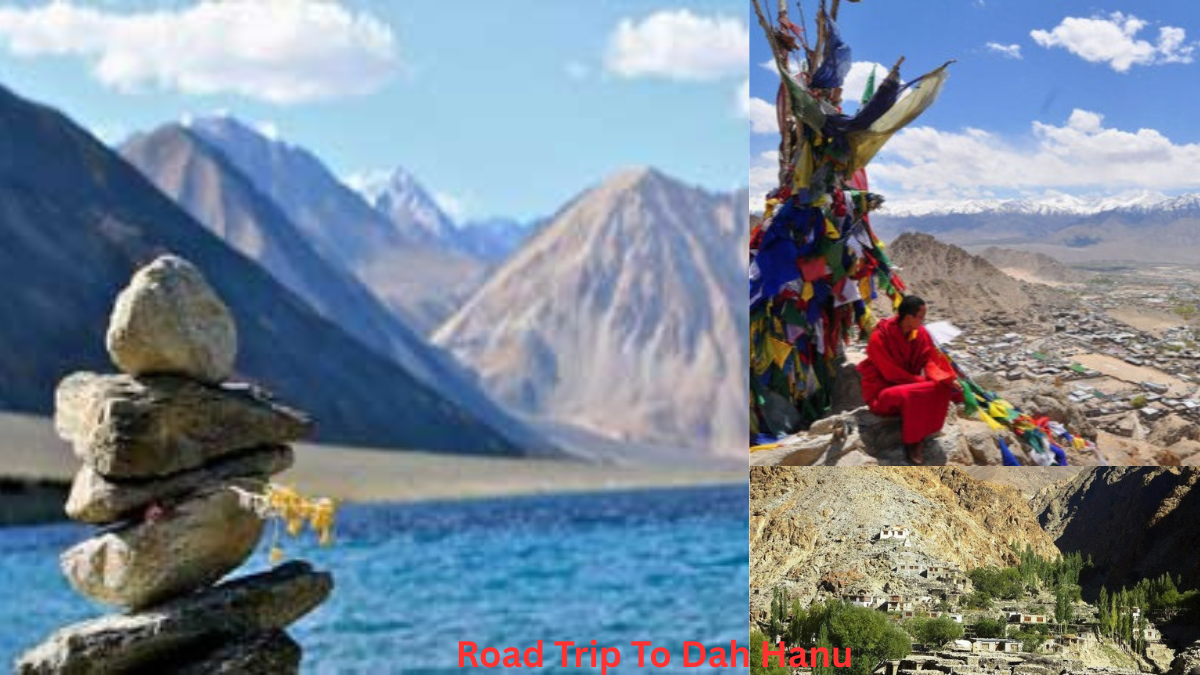Nestled deep within the rugged terrains of Ladakh lies Dah Hanu two villages that defy time, modernity and even the very idea of cultural assimilation.These are not just remote hamlets; they are living museums of the Brokpa people, often referred to as the “last Aryans of India.” With their striking features, vibrant traditions and fiercely preserved identity, Dah and Hanu offer an experience that is as enigmatic as it is unforgettable.
The road to Dah Hanu village in Ladakh stretched endlessly from Leh, winding through stark, silent valleys and ancient mountain passes.After crossing the revered Alchi Monastery, we traced the serpentine flow of the Indus River, steadily making our way toward the Pakistani border.The raw, untamed beauty of the high-altitude desert jagged cliffs flanking the ever-moving river offered a visual feast that kept the photographer in me utterly absorbed. I longed to lean out of the window, as I had on my last Ladakh adventure, but the biting cold hovering at a bone-chilling -1°C made that thought vanish quickly. Apart from a brief breakfast halt in Khaltse, where steaming tea and thukpa revived our spirits, the journey remained uninterrupted until we rolled into what looked like a lone house standing in solitude an eerie,near-mythical outpost lost in the folds of Ladakh’s forgotten lands.What truly sets the Brokpa community apart beyond their distinct features and isolated culture is the swirling speculation around what many have dubbed “pregnancy tourism.” While rarely acknowledged in official discourse, local whispers and traveler anecdotes speak of a curious trend: foreign women, particularly from European countries like Germany, journeying into the secluded valleys of Dah Hanu and neighboring villages with the intention of conceiving children with Brokpa men. The driving force? A desire to bear offspring perceived to carry “pure Aryan blood.”
Historically, the term “Aryan” referred to Indo-Iranian peoples, but over time, it evolved often controversially to describe certain Indo-European populations, commonly stereotyped as tall, fair-skinned, blue-eyed and blonde-haired. The word itself translates to “noble,” and for some it evokes a romanticized (and deeply flawed) vision of genetic purity.
Although these claims remain unverified and lack any official confirmation, the topic has drawn international intrigue. Several documentaries and independent research projects have explored the phenomenon, attempting to separate fact from myth. Yet, the line between cultural curiosity and ethical concern grows ever thinner, leaving behind a trail of questions about identity, exoticism and the global gaze on this ancient community.
The ideal time to visit the village is between June and October.
The climate and atmosphere are unbearably hot throughout the summer, reaching temperatures of 40 degrees Celsius.
Places To Explore In Dah and Hanu Ladakh
While heading to Dah & Hanu Village, one can stop at several interesting locations. A few of these locations are
-Hall of Fame
-Shanti Stupa
-The Lamayuru Monastery
-Shey Palace
-Kargil City View Point
-Spituk Gompa
-Shakar Fort
-Leh Market
Food at Dah and Hanu Village
There aren’t many eating options here. Since the community has no distinctive cuisine or characteristics, there is no selection of food. There are no restaurants in the area except for the tribal cuisine. Therefore, if you wish to explore the area for a greater number of days, you must make personal arrangements or bring extra food.
The Brokpas: Guardians of an Ancient Lineage
The Brokpas, also known as Dards or Drokpas, are believed to be descendants of Alexander the Great’s army, having settled in the Dah Hanu region over two millennia ago. Their distinct Indo-European features—fair skin, high cheekbones, and light-colored eyes—set them apart from other Ladakhi communities. This unique appearance, coupled with their commitment to endogamy, has preserved their genetic lineage over centuries. Their language, Brokskat, is a Dardic tongue that further distinguishes them from neighboring tribes. Despite the passage of time, the Brokpas of Dah Hanu have maintained their linguistic and cultural heritage, resisting the homogenizing forces of globalization.
A Culture Rooted in Nature and Ritual
The Brokpa culture is a tapestry woven with threads of animism, Buddhism and ancient traditions. They revere natural elements, with the ibex considered a sacred animal. Their festivals, such as Bononah and Nagrang are vibrant celebrations that mark agricultural cycles and seasonal changes. These events feature elaborate rituals, traditional dances and communal feasts, offering a window into their rich cultural tapestry.
Traditional attire is another hallmark of Brokpa identity. Men and women adorn themselves with elaborate headgear decorated with flowers, beads and silver ornaments. This distinctive dress not only showcases their aesthetic sensibilities but also serves as a symbol of their cultural pride.
Life in Dah and Hanu: A Harmonious Existence

Situated along the banks of the Indus River, Dah Hanu are surrounded by lush greenery, a rarity in the arid landscape of Ladakh. The villages are characterized by stone houses, terraced fields and orchards of apricots and apples. Agriculture remains the primary occupation, with residents cultivating crops and rearing livestock such as goats, cows and yaks.
Despite the challenges of modernization, the Brokpas have managed to strike a balance between tradition and progress. While younger generations seek education and employment opportunities in urban centers, many return to their roots, contributing to the community’s sustainability.
Visiting Dah and Hanu: A Journey Off the Beaten Path
Traveling to Dah Hanu is an adventure in itself. Located approximately 163 kilometers from Leh, the journey involves traversing winding mountain roads and crossing high-altitude passes. The best time to visit is between June and October when the weather is favorable and the villages are accessible.
Accommodation options are limited, with homestays offering the most authentic experience. Staying with a Brokpa family provides insight into their daily lives, customs and traditions. It’s an opportunity to engage with a community that has remained largely untouched by the rapid changes of the modern world.
Cultural Sensitivity and Responsible Tourism
While Dah Hanu welcome visitors, it’s crucial to approach these communities with respect and sensitivity. Photography, especially during religious ceremonies, should be undertaken only with permission. Visitors are encouraged to dress modestly and adhere to local customs to ensure a respectful and enriching experience for both guests and hosts.
Conclusion: A Living Legacy
Dah Hanu are more than just picturesque villages; they are custodians of a unique cultural and genetic heritage. In an era where globalization threatens to erode distinct identities, the Brokpas stand as a testament to the resilience of tradition. A visit to these villages is not merely a journey through stunning landscapes but a voyage into a living legacy that continues to thrive against the odds.
